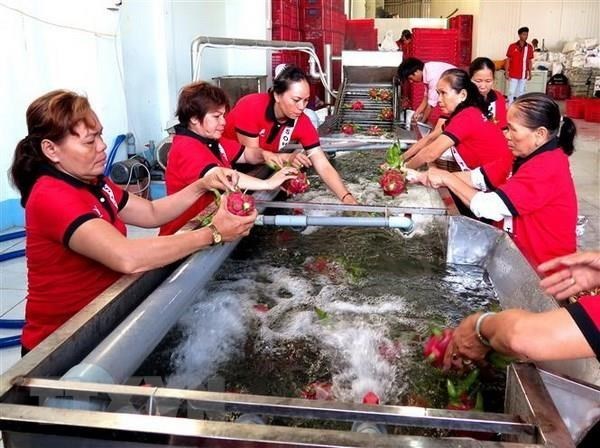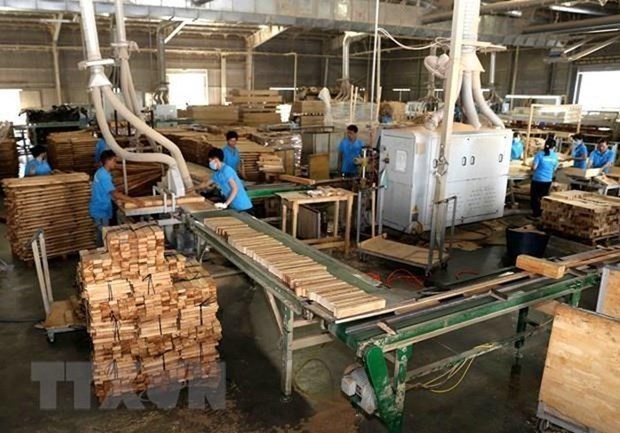Agro-forestry-fishery exports targeted at over 42 bln USD for 2020
For 2020, Vietnam’s agricultural sector targets a gross domestic product (GDP) growth rate of 2.8 – 3 percent and an agro-forestry-fishery export turnover of more than 42 billion USD.
 Workers process shrimp for export (Photo: VNA)
Workers process shrimp for export (Photo: VNA)Hanoi (VNA) – For 2020, Vietnam’s agricultural sector targets a gross domestic product (GDP) growth rate of 2.8 – 3 percent and an agro-forestry-fishery export turnover of more than 42 billion USD.
In 2019, the agro-forestry-fishery export revenue is estimated at 41.3 billion USD, rising 3.5 percent from the previous year. It also posted a record trade surplus of 9.9 billion USD, 1.12 billion USD higher than in 2018.
The year 2020 is important to making breakthroughs to complete the five-year plan for 2016 – 2020.
Nguyen Van Viet, Director of the Planning Department under the Ministry of Agriculture and Rural Development (MARD), said in the time ahead, the sector will push ahead with agriculture restructuring in association with growth model reform and new-style rural area building, and boosting production under value chains.
It will continue to coordinate with localities to capitalise on the advantages of tropical agriculture, develop large-scale specialised farming areas, and connect agricultural activities with processing, preservation, the market and export.
[Agricultural sector gains trade surplus of 8.8 bln USD in 11 months]
MARD Minister Nguyen Xuan Cuong said in the coming time, the agricultural sector will develop groups connecting the production, processing and sale of farm produce in the localities and regions that have big agricultural output; favourable transport, labour and logistics conditions; and potential to become growth momentum for their respective regions.
The ministry will select major businesses with high capability in terms of capital, technology and market to lead those connection chains, he said, noting that it will also create an open and optimal environment for investment in agro-forestry-fishery processing.
A general development plan for agricultural processing, as well as plans for developing potential commodities like fruits, vegetables, aquatic products and wood items, will be built to set up long-term orientations basing on which enterprises will make investment.
Besides, the MARD will consider removing barriers, administrative procedures and unnecessary business conditions, while fine-tuning investment attraction policies to suit different regions and commodities, Cuong noted.
 Workers clean dragon fruits for export (Photo: VNA)
Workers clean dragon fruits for export (Photo: VNA)It is set to create a favourable legal framework and support policies for the transaction of farmland, while permitting enterprises to purchase and rent land from farmers to develop large-scale specialised farming to ensure material supply for processing.
He added the ministry will develop big and modern businesses with high competitiveness in agro-forestry-fishery processing, along with small- and medium-sized processing firms to help farmers ensure stable sale of produce.
Processing will also be enhanced for the commodities that still lack processing facilities and those that are key products of the country, the official said.
In 2019, despite numerous difficulties like the African swine fever epidemic, sharp falls in prices of many agricultural products, impact of trade tensions between big countries, and changes in China’s import regulations, the agricultural sector carried out solutions to overcome those challenges.
Right from the outset of the year, it paid special attention to promoting agro-forestry-fishery product trading, removed obstacles in a timely manner to boost shipments to traditional markets, and explored potential ones. As a result, the number of businesses licensed to sell aquatic products to the European Union, the Republic of Korea, China and Russia increased continuously.
Nguyen Quoc Toan, Director of the MARD’s Agro Processing and Market Development Department, said the ministry enhanced negotiations so that more fresh fruits with high value could be shipped to the US, Australia, Japan and China.
 A wood processing factory in Lam Dong province (Photo: VNA)
A wood processing factory in Lam Dong province (Photo: VNA)Notably, mango became the sixth fruit from Vietnam that had been sold to the US, following lychee, longan, rambutan, star apple and dragon fruit. Lychee also successfully entered the Japanese market in the year.
Although China, the biggest destination of Vietnamese agricultural products, changed many import policies, the sector worked hard to facilitate the shipment of salangane nest, cassava, fruit and aquatic products to this market, and popularised new regulations of this market to businesses.
So far, China has allowed the import of nine fruits, along with 48 fresh and 128 processed aquatic products from Vietnam. Vietnamese dairy products also managed to enter the world’s most populous country.
Besides, the US recognised that Vietnam’s inspection system of Siluriformes fish, including tra fish, is equivalent to the system that the US has established under the Federal Meat Inspection Act and its implementing regulations. This move has helped Vietnam increase exporters of tra fish to the North American nation.
Meanwhile, the Voluntary Partnership Agreement (VPA) on Forest Law Enforcement, Governance, and Trade (FLEGT) between Vietnam and the EU was signed and took effect, showing Vietnam’s strong commitment to not only the EU but also all the markets Vietnam is trading forestry products with about the transparency of its forestry sector./.













